Hello friends of steemit, for some time I wanted to publish this practical work, which is related to my thesis degree, which has a very particular name, it is called "Genetic Study Microscopic applying Petrology" - "Petrographic Description", in this present blog, we talk about the most important aspects, such as the basic definitions, properties of rocks, the study of petrology is one of the branches of geology that deals with the study of rocks from the genetic point of view and of your relationships with other rocks. It is considered one of the main branches of geology.
The study of the petrology of sediments and sedimentary rocks is known as sedimentary petrology. Petrography, a related discipline, deals with the description and characteristics of crystalline rocks determined by microscopic examination with polarized light. I invite you to observe this interesting post related to my degree study !!
Petrology Petrographic Descriptions
Petrology studies the rocks as a whole, their geometric field characteristics, petrographic characteristics (components), detailed chemical composition of the same and the different minerals that constitute it, physical-chemical formation conditions and the evolutionary processes during its genesis.
The petrographic studies approach the physical description in visual terms of the rocks, by means of the microscopy of polarized light (essentially with transmitted light, although also reflected, and in some cases electron microscopy). These studies offer valuable information regarding the nature of their components (essentially minerals), their abundances, shapes, sizes and spatial relationships, which allows classifying the rock and establishing certain qualitative or semiquantitative conditions of formation, as well as possible evolutionary processes.
The petrographic components are those components of the rock that have a physical entity, such as mineral grains, particular associations of certain minerals, other fragments of rocks related or not genetically with the rock that includes them, components of the matrix and cement, amorphous material or cryptocrystalline (volcanic glass, silica gels ...), empty spaces (pores, vacuoles ...), discrete or sealed fractures, etc.
Some petrographic components occur in all types of rocks, such as mineral grains or pores, which are very abundant in sedimentary and igneous volcanic rocks, but are very small and scarce in metamorphic and igneous plutonic rocks; others occur only in some types, such as volcanic glass in volcanic magmatic rocks; others occur in any of the rocky types but only occasionally, such as fractures.
Mutual spatial relations
- Texture
- Structure
- Factory
- Matrix and cement
Mutual spatial relations
The following concepts are distinguished:
Texture
It is the set of intergranular spatial relationships and morphological characteristics (size and shape) of the components (essentially grains and / or mineral aggregates) of the rock. The textural denominations and the criteria used vary according to the type of rock considered.
There are many types of spatial and morphological relationships between the components of rocks, that is, textures. However, five basic textural types can be established for all natural rocks, with different textures being combinations of two or more of the five types described below.
Sequential texture (or serial)
Consisting of crystals that have grown from a liquid solution (i.e. magma or aqueous solution) or gas (i.e. fluids). The crystals of the different minerals have grown at different times and therefore will have different morphological characteristics. This type of texture applies to all types of rocks, although it is typical of plutonic and volcanic igneous rocks and some sedimentary rocks.
The order of crystallization can be inferred from morphological criteria and inclusion relationships. Thus, in general, crystals that have crystalline forms (i.e. idimorphs or hipidiomorphs) will have crystallized before those that do not present them (i.e. xenomorphs), and the crystals included in others will have grown earlier than those that include them.
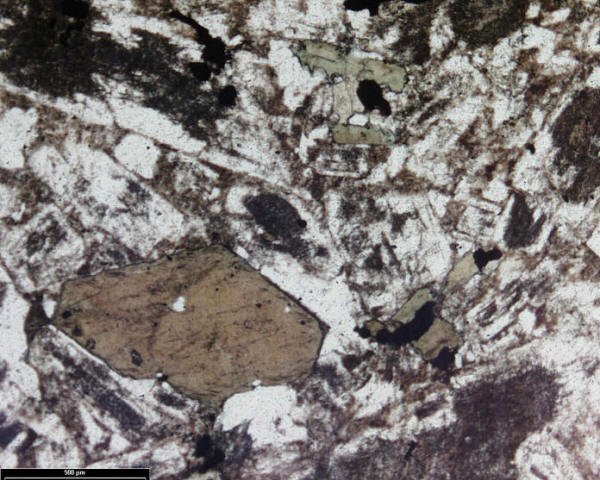
Sequential texture or serial (granodiorite with amphibole, Tutor of Petrology). Parallel polarizers.
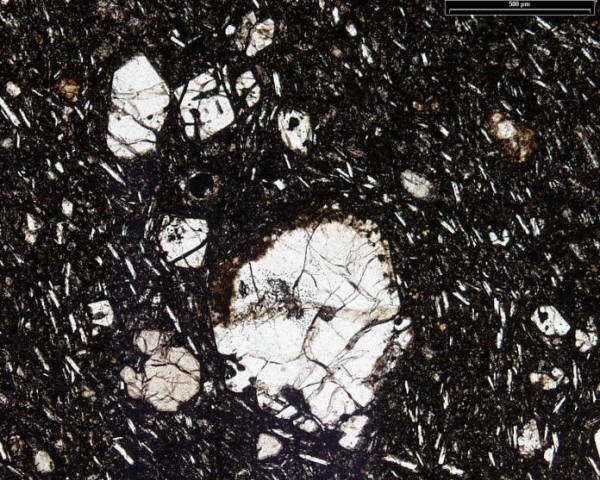
Sequential or serial texture (basalt, Petrology Tutor). Parallel polarizers.
Vitreous texture
Constituted totally or partially by glass formed by rapid solidification of a magmatic melt. This texture is typical of volcanic igneous rocks. The glass is observed as an amorphous substance that encompasses the possible existing crystalline grains, and where empty spaces can appear, globally called vacuoles (the term of pore is specifically applied to sedimentary rocks).
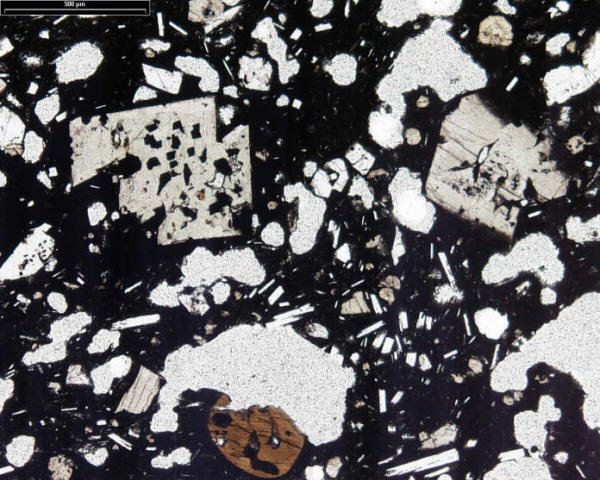
Vitrea texture (basalt, Petrology Tutor). The black parts correspond to glass. Parallel polarizers.
Clastic texture
Formed by fragments of rocks and / or minerals encompassed or not in a finer fragmentary material and / or precipitated and / or recrystallized. This texture applies specifically to detrital sedimentary rocks, although some volcanic rocks also present it. Fragments of rocks and minerals (of any kind) are called clasts; The material that encompasses them is called a matrix or cement according to this constituted by very fine grain detritic material or by precipitates of variable crystallinity, respectively. The concepts of matrix and cement are discussed later because their application to different types of rocks is variable.
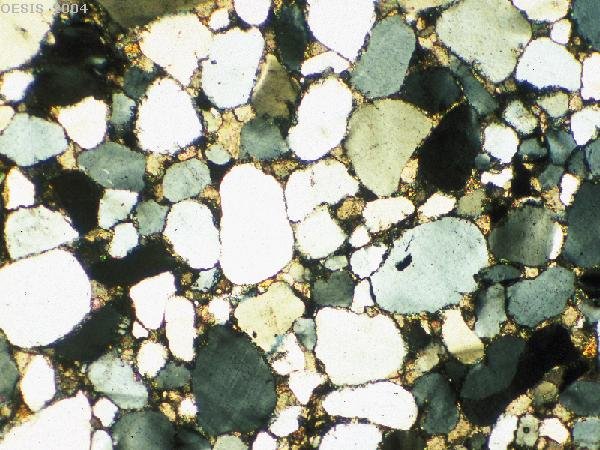
Clastic texture. (Sandstone; Oxford Earth Sciences Image Store). Horizontal dimension 3.5 mm, crossed polarizers.
Blastic texture
Consisting of crystals that have been formed in a solid medium by pre-existing mineral transformations. This type of texture applies specifically to metamorphic rocks. The transformations suffered include essentially changes in the sizes and shapes of the crystals and primary constituents and the formation of new minerals that did not exist before. The recrystallized or newly formed mineral grains are called blasts.
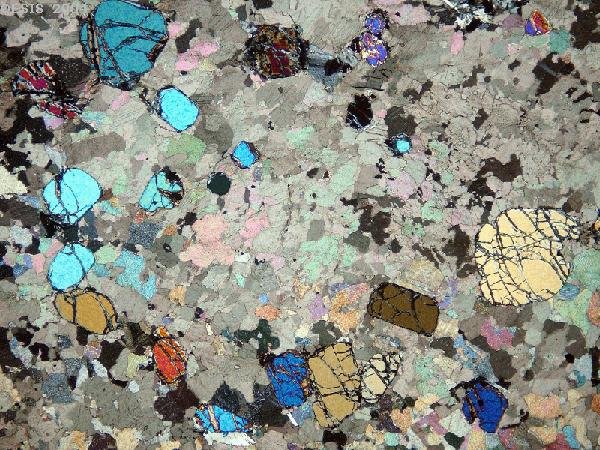
Blastic texture (olivine marble, Oxford Earth Sciences Image Store). Horizontal dimension 6 mm, crossed polarizers.
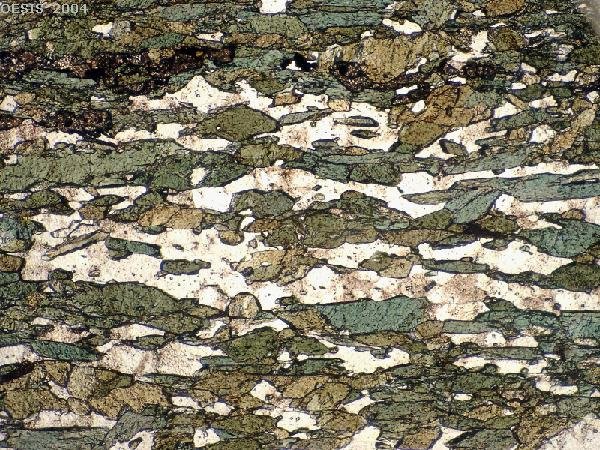
Blastic texture (amphibolite, Oxford Earth Sciences Image Store). Horizontal dimension 2 mm, parallel polarizers. In this case, the texture is oriented (deformed).
Deformed texture
The components of the rock, whether crystals, clasts, blasts, empty spaces, etc., are deformed. This texture applies to any type of rock, although it is typical of most metamorphic rocks since natural deformation processes are often accompanied by significant textural and mineralogical changes in the affected rocks. Deformed textures are easily identified since the components adopt preferential orientations (factory), the minerals show evidence of deformation such as undulating extinctions, fractures or microfractures develop, etc. In general, a deformed texture is formed on a pre-existing texture, which may or may not be evidence.

Deformed texture (folded shale, Oxford Earth Sciences Image Store). Horizontal dimension 3 mm, parallel polarizers.

TEXTURAL PATTERN
It is the set of non-compositional characteristics that can be used to distinguish one type of rock or group of rocks from the others, regardless of the mineralogical composition. In the concept of textural pattern is broader than the texture, including the structure and factory, depending on the type of rock considered.
Structure and microstructure
Distribution and spatial order of the crystals or grains within the rock at macroscopic and microscopic scales, respectively. The most common types of structures are:
Homogeneous or massive. There is no preferential distribution of the components.
Banded Preferential disposition of the components in more or less planar, curved or irregular bands.
Nodulose Preferential arrangement of the components in spherical or ellipsoidal aggregates (nodules).
Brechoide. Produced by fracturing the rock irregularly or with preferential orientation of the fractures.
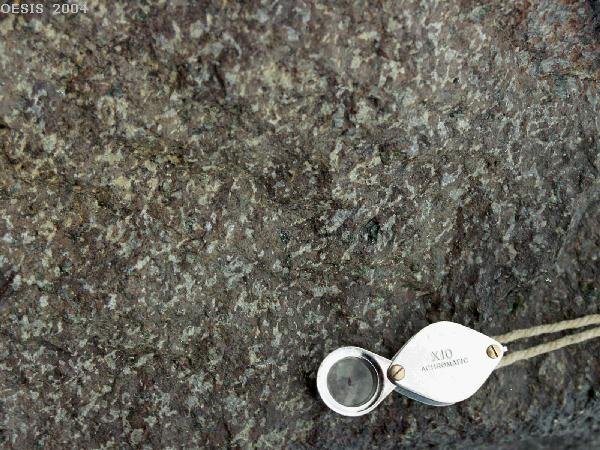
Homogeneous structure (gabbro, Oxford Earth Sciences Image Store).
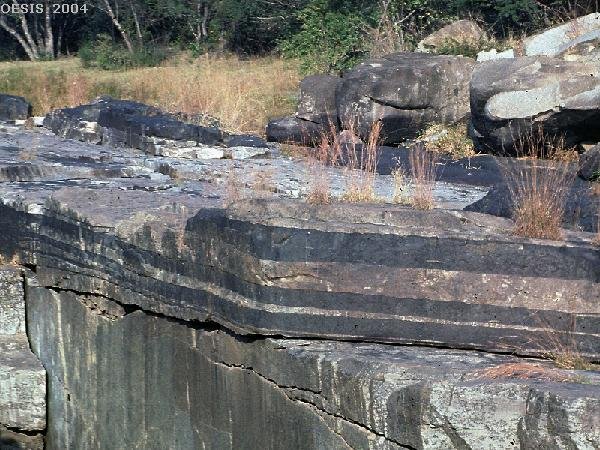
Banded structure (layers of chromite and mafic-ultramafic rocks, Oxford Earth Sciences Image Store).
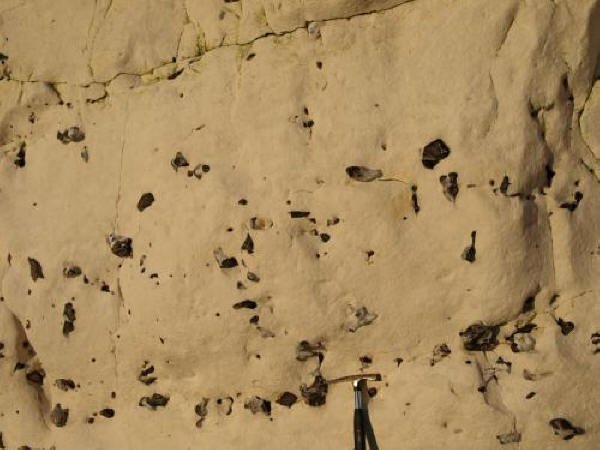
Nodular structure (chert in limestone, GeologyRocks).
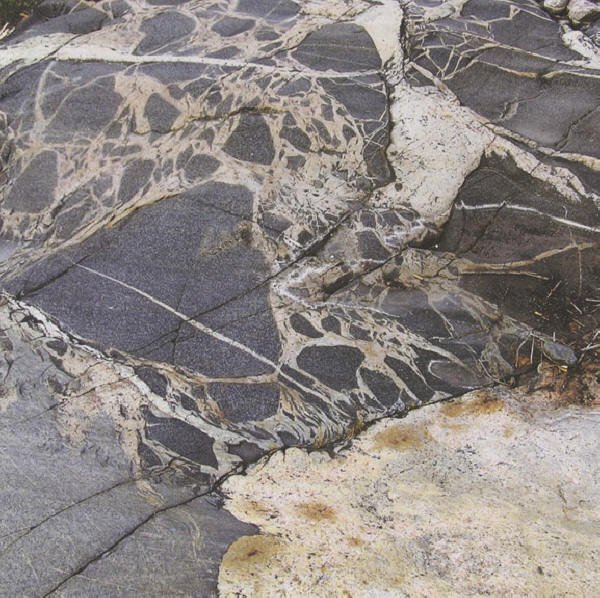
Brechoid structure (granite-diorite magmatic gap, Journal of Geoscience Education).

Brechoid structure (brechoid limestone (About.com: Geology)
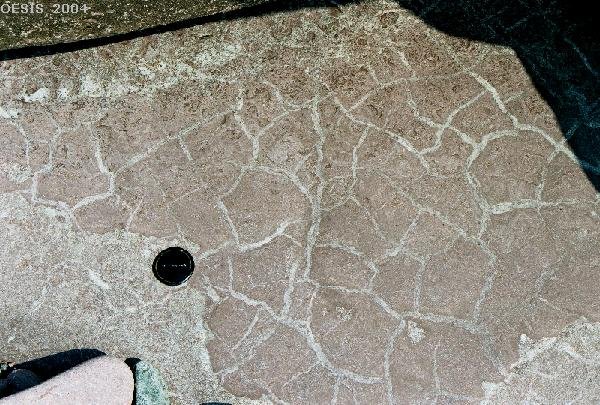
Brechoid structure (brechish chert with filled fractures, Oxford Earth Sciences Image Store)
Crystallographic factory and factory
Preferential spatial orientation of non-equidimensional components and crystallographic elements (axes, planes) of minerals within a rock, respectively. For the determination of the crystallographic factory it is necessary to resort to special techniques (universal plate, X-ray diffraction). The types of existing factories are four:
Isotropic There is no preferential orientation of the components.
Linear. Orientation of the components in one direction.
Planar. Orientation of the components in a plane.
Plane-linear. Orientation of the components in a direction within a plane.

Isotropic, linear, planar and plane-linear factories (University of California at Santa Cruz Structural Geology · Foliations and lineations)

Isotropic factory (gabbro, Oxford Earth Sciences Image Store).
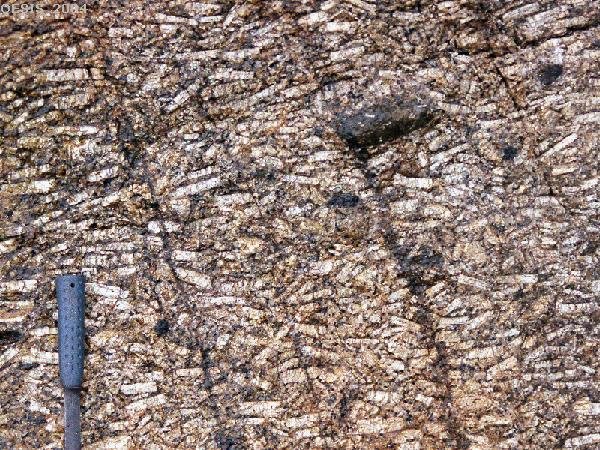
Planar factory (granite, Oxford Earth Sciences Image Store). Orientation of (tabular) potassium feldspar crystals (ortosa / microcline).
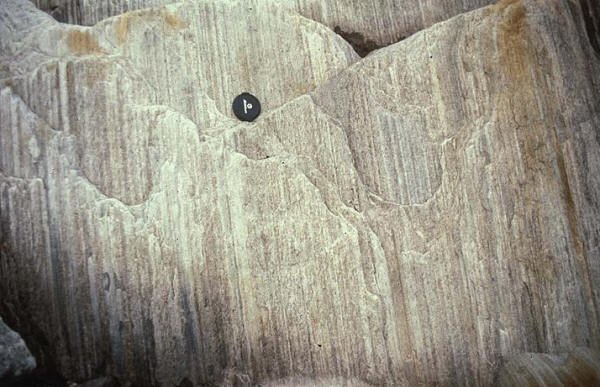
Generally the rocks with factory are deformed rocks, so the original components that were equidimensional can stop being so (by plastic deformation) and acquire preferential orientation, and those that are not can rotate and orient themselves. The majority of metamorphic rocks tend to present varied factories, as in the case of some marbles that have preferential morphological and crystallographic orientations of the calcite (and / or dolomite) grains. However, the preferential orientation of the components does not have to be due to deformation in the solid state. Igneous rocks, for example, can present planar factories when they accumulate by decanting crystals with non-isometric habits at the bottom of magmatic chambers. In the same way, sedimentary rocks can present preferential orientations due to the processes of transport of the clasts in dynamic media such as rivers, or by compaction when other materials are deposited on porous sediments (in this case the preferred orientation is acquired by crushing and by therefore by deformation).
Matrix and cement
Often, in all types of rocks a clearly bimodal size relationship is observed between the solid components (minerals or rock fragments), that is, some have a relatively thicker grain size than others. In general, the population of fine components is called a matrix, although this concept has different connotations depending on the rock to which it is applied. In igneous rocks the matrix is the fine fraction, cryptocristraline or vitreous in which the mineral grains of larger grain size are found, and which normally has crystallized after the latter. In the sedimentary rocks, the matrix is the fine fraction (usually clay mud, carbonate ...) that supports the clasts, and whose formation is contemporary with the sedimentation of them. In metamorphic rocks the matrix is also the finest fraction, and its origin is metamorphic, anterior, contemporary or posterior to that of the major blasts. In deformed rocks, the matrix is the fine fraction that is originated by the crushing of previous grains, reducing the grain size.
The cement concept applies specifically to sedimentary rocks and altered rocks of any kind. It is the material formed generally after the deposit of the rock, by means of precipitation processes from ionic or colloidal aqueous solutions that circulate and interact with the rocks. In sedimentary rocks, these cements are usually formed during diagenetic processes. The cements may or may not have a grain size greater than that of the components of the rocks, being one of the factors that produce a reduction in the porosity of the rocks and, in general, a greater degree of mechanical strength and cohesion between the components of the rocks.
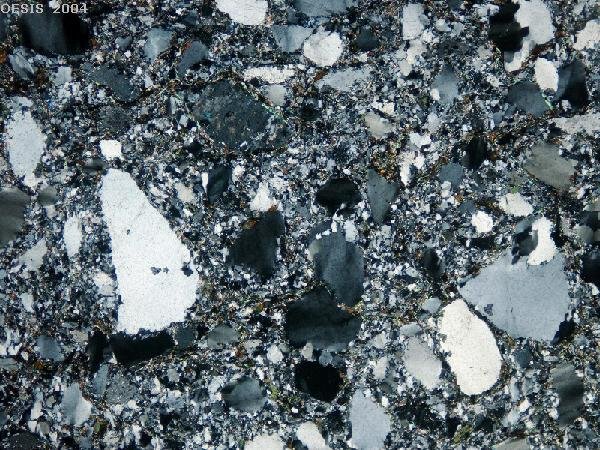
Detrital matrix (grauvaca sandstone, Oxford Earth Sciences Image Store). Horizontal dimension 5 mm, crossed polarizers.

Carbonate cement (oolitic limestone, Oxford Earth Sciences Image Store). Horizontal dimension 3 mm, parallel polarizers.
References :
- Kerr, P. F. Optical mineralogy. Madrid (1972).
- Licker, M. D. (ed.) (2003). Dictionary of Earth Science. New York: McGraw-Hill.
- Tarbuck, E.J. and Lutgens, F.K. (2005): Earth Sciences: An Introduction to Physical Geology. 8th ed. 710 pp. Pearson Prentice Hall.
- Monroe, J.S .; Wicander, R .; and Pozo Rodriguez, M. (2008): Geology: Dynamics and evolution of the Earth. Paraninfo, 726 pp.
- Águeda, J .; Anguita, F .; Spider, V .; López, J .; Sanchez de la Torre, L. (1983): Geology, (2nd ed.). Ed. Rueda. 528 pp.
- Anguita, F .; Moreno, F. (1991): Internal geological processes. Ed. Rueda, 232 pp.
- Anguita, F .; Moreno, F. (1993): External geological processes and environmental geology. Ed. Rueda, 311 pp.
Hello,
We have found similar content:
Textura Por El Tamaño Absoluto de Rocas Ígneas
Not indicating that the content you post including translations, spun, or re-written articles are not your original work could be seen as plagiarism.
These are some tips on how to share content and add value:
Repeated plagiarized posts are considered spam. Spam is discouraged by the community, and may result in action from the cheetah bot.
If you are actually the original author, please do reply to let us know!
Thank You.
More Info: Abuse Guide - 2017.
really very interesting post
keep posting such more!!
best regards!
cheers!!